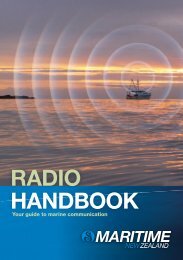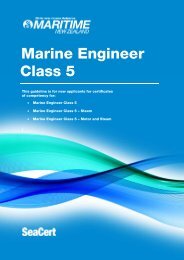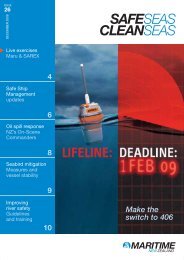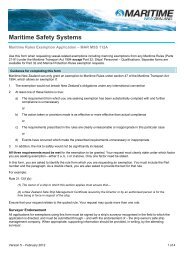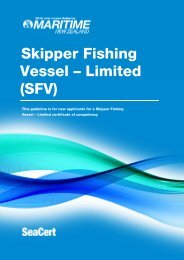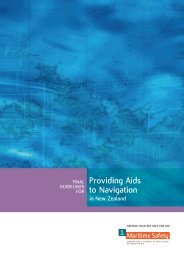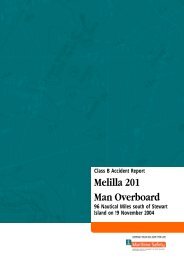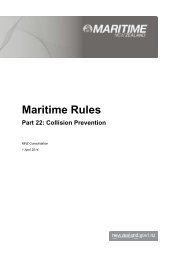New Zealand oil spill response strategy - Maritime New Zealand
New Zealand oil spill response strategy - Maritime New Zealand
New Zealand oil spill response strategy - Maritime New Zealand
Create successful ePaper yourself
Turn your PDF publications into a flip-book with our unique Google optimized e-Paper software.
All <strong>New</strong> <strong>Zealand</strong> marine waters are designated as pre-approved for dispersant application, unless<br />
specifically excluded in either a regional plan or the National Marine Oil Spill Contingency Plan. In all<br />
cases, the NOSC has the authority to use dispersant even in excluded areas, if this will lead to the<br />
greatest net environmental benefit. Oil Spill Dispersant Guidelines for use in <strong>New</strong> <strong>Zealand</strong> have been<br />
produced to assist the decision making process. 4<br />
Shoreline Response<br />
Once <strong>oil</strong> has reached the shore, the environmental impact and cost of cleaning are often much greater<br />
than if the <strong>spill</strong> had been dealt with at sea.<br />
The primary options for shoreline <strong>response</strong> are:<br />
• Pre-cleaning (to improve access and reduce waste);<br />
• Mechanical and/or manual clean-up;<br />
• Natural recovery;<br />
• Bioremediation (using living organisms to speed <strong>oil</strong> degradation).<br />
A recent innovation to shoreline <strong>response</strong> has been the development of Shoreline Clean-up<br />
Assessment Treatment (SCAT). This involves delineating the impacted coast into homogenous<br />
segments, and gathering data on each to assist prioritisation. This process can be augmented by pre<strong>spill</strong><br />
segmentation at the contingency planning stage, to speed <strong>response</strong>s during an incident.<br />
Wildlife Response<br />
The aim of wildlife <strong>response</strong> is to avoid, remedy or mitigate any detrimental impacts on wildlife during<br />
an <strong>oil</strong> pollution <strong>response</strong>. This primarily concerns marine and coastal birds, reptiles, and where safety<br />
allows, marine mammals, due to their susceptibility, protection status and community expectations.<br />
While the OSC is directly responsible for ensuring there is a credible and effective wildlife <strong>response</strong>,<br />
additional specific expertise will be needed. <strong>Maritime</strong> <strong>New</strong> <strong>Zealand</strong> has contracted Massey University<br />
to develop and maintain a Tier 3 wildlife <strong>response</strong> operational plan annexed to the National Plan, a<br />
national wildlife treatment facility, and personnel and equipment for use during <strong>spill</strong> <strong>response</strong>. The<br />
Department of Conservation and Tangata Whenua should also be involved where protected or<br />
culturally significant species (see Appendix 5) are threatened, and as key conservation management<br />
stakeholders.<br />
Wildlife <strong>response</strong> will, whenever possible adhere to international best practice protocols while<br />
prioritising human safety as well as animal welfare. Where appropriate, it may involve exclusion<br />
(‘hazing’), and/or pre-emptive capture. In all cases, monitoring of rescued and released wildlife should<br />
be an integral component of the rehabilitation process providing feedback to improve efficiency of ongoing<br />
operations.<br />
Should a <strong>spill</strong> occur whereby there is no direct <strong>response</strong> action to contain and recover the <strong>oil</strong>, wildlife<br />
<strong>response</strong> may be the only intervention activity undertaken.<br />
Wildlife <strong>response</strong> costs authorised by the OSC are fully recoverable from the <strong>spill</strong>er, under both the<br />
<strong>Maritime</strong> Transport Act and the Civil Liability Convention 1969. It is recognised that <strong>oil</strong>ed wildlife may<br />
be discovered after other <strong>response</strong> efforts have ceased, and this should be taken into account during<br />
de-escalation and termination.<br />
Oil Spill Response Capability<br />
Though an effective <strong>response</strong> capability has been firmly established in <strong>New</strong> <strong>Zealand</strong> under the<br />
previous <strong>response</strong> strategies, every effort should be made to ensure continuous development, with a<br />
strong commitment to build experience in personnel.<br />
Equipment<br />
<strong>Maritime</strong> <strong>New</strong> <strong>Zealand</strong> will allocate sufficient basic equipment to the regional councils to respond to<br />
<strong>spill</strong>s identified in the risk assessment as likely to occur within their individual boundaries. The amount<br />
of equipment deployed in the regions depends on the potential size of <strong>oil</strong> <strong>spill</strong>s identified and the type<br />
of product e.g., those with major <strong>oil</strong> terminals have more specialist equipment. This gives each region<br />
4<br />
Available on request from <strong>Maritime</strong> <strong>New</strong> <strong>Zealand</strong> or the Cawthron Institute.<br />
18





